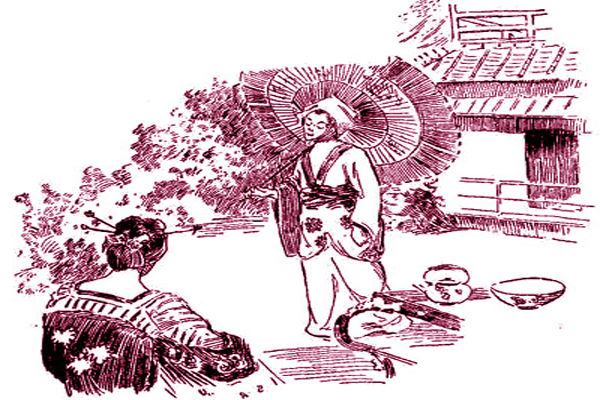Little Cups of Chinese and Japanese Tea
Many exotic legend exist, but at any rate it is easy to believe that the Chinese were first in the tea infusion. It is certain that Chinese, first in many things, were not only more progressive than other peoples, but linked with their progress were important researches, and invaluable discoveries, which the civilized world has long ago recognized. Then, why not add custom of making of tea to the list?
At any rate, it is easy to believe that the Chinese were first in the tea fields, and that undoubtedly the plant was a native of both China and Japan when it was slumbering on the slopes of India, unpicked, unsteeped, undrunk, unhonored, and unsung.
A celebrated Buddhist, St. Dengyo Daishai, is credited with having introduced tea into Japan from China as early as the fourth century.
It is likely that he was the first to teach the Japanese the use of the herb, for it had long been a favorite beverage in the mountains of the Celestial Kingdom. The plant, however, is found in so many parts of Japan that there can be little doubt but what it is indigenous there as well.
The word TEA is of Chinese origin, being derived from the Amoy and Swatow reading, "Tay," of the same character, which expresses both the ancient name of tea, "T'su," and the more modern one, "Cha." Japanese tea, "Chiya"--pronounced Châ.
Tea was not known in China before the Tang dynasty, 618-906 A.D. An infusion of some kind of leaf, however, was used as early as the Chow dynasty, 1122-255 B.C., as we learn from the Urh-ya, a glossary of terms used in ancient history and poetry. This work, which is classified by subjects, has been assigned as the beginning of the Chow dynasty, but belongs more properly to the era of Confucius, K'ung Kai, 551-479 B.C.
Although known in Japan for more than a thousand years, tea only gradually became the national beverage as late as the fourteenth century.
In the first half of the eighth century, 729 A.D., there was a record made of a religious festival, at which the forty-fifth Mikado---"Sublime Gate"--Shommei Tenno, entertained the Buddhist priests with tea, a hitherto unknown beverage from Corea, which country was for many years the high-road of Chinese culture to Japan.
After the ninth century, 823 A.D., and for four centuries thereafter, tea fell into disuse, and almost oblivion, among the Japanese. The nobility, and Buddhist priests, however, continued to drink it as a luxury.
During the reign of the eighty-third Emperor, 1199-1210 A.D., the cultivation of tea was permanently established in Japan. In 1200, the bonze, Yei-Sei, brought tea seeds from China, which he planted on the mountains in one of the most northern provinces. Yei-Sei is also credited with introducing the Chinese custom of ceremonious tea-drinking. At any rate, he presented tea seeds to Mei-ki, the abbot of the monastery of To-gano (to whom the use of tea had been recommended for its stimulating properties), and instructed him in the mystery of its cultivation, treatment, and preparation. Mei-ki, who laid out plantations near Uzi, was successful as a pupil, and even now the tea-growers of that neighborhood pay tribute to his memory by annually offering at his shrine the first gathered tea-leaves.
After that period, the use of tea became more and more in fashion, the monks and their kindred having discovered its property of keeping them awake during long vigils and nocturnal prayers.
Prom this time on the development and progress of the plant are interwoven with the histories and customs of these countries.

Education
Discover where the capital of the United States has been located...In Memory of Myron Angus - One Truly Amazing Man
Many people found inspiration through Myron Angus, a talented handicapped artist of international fame, who created all his works through painting with his mouth. He has mastered that fascinating technique of painting with the brush held between his teeth, and had ability to talk and paint at the same time. A simple dowel-rod with a rubber tip held between his teeth and his determination made it all possible. This other way of doing things didn't just happen over night.
When Myron was about 7 years old, his parents were visiting the C.N.E. in Toronto, Ontario. There, they came across a man by the name of Bill Watson (Canadian author and journalist William Ritchie Watson) at one of the displays. He was autographing the book "My Desire" which he had written by holding a pen in his mouth, he had no arms. When Mr. and Mrs. Angus told him about their son, he autographed a copy of the book special for Myron. Then he told them to put a pencil between his teeth. Let him learn to control the pencil this way, then put him in school.

